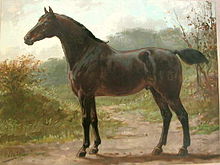East Frisians / Old Oldenburg
| East Frisians / Old Oldenburg | |
|---|---|

Two East Frisians / Old Oldenburg geldings as the front horses in front of a multiple horse |
|
| Important data | |
| Origin: | East Frisia , Oldenburg |
| Main breeding area: | Lower Saxony |
| Distribution: | low |
| Stick measure : | 158-168 cm |
| Colors : | Foxes, black horses, browns, white horses |
| Main application area: | Driving horse |
Horses of formerly independent breeds for which a joint stud book has existed since the late 1980s are referred to as old Oldenburg and East Frisians . The horse breed is now known under the common name Ostfriese / Alt-Oldenburger .
Background information on horse evaluation and breeding can be found under: Exterior , interior and horse breeding .
Exterior
The Ostfriesen / Alt-Oldenburger is a heavy warmblood . The horses should have good, expansive gaits. A height of approx. 158–168 cm and a cannon bone circumference of approx. 22–24 cm for three-year-old horses are aimed for.
For the exterior, a medium-weight, sufficiently elegant, caliber horse with large lines and clear contours in a rectangular format is desirable. The head should be expressive and distinctive (no pike head), the neck of medium length and strongly muscular.
The brown and black horses predominate, but foxes and white horses can also be found in the East Frisian-Old Oldenburg breed.
interior
Old Oldenburg and East Frisians are versatile driving horses with good riding characteristics. The breeding goal provides for a balanced, calm temperament as well as motivation and performance.
Breeding history
As early as the Middle Ages, noble horses of other breeds were crossbred for East Frisian horses. Breeding developed early on in the direction of heavy coach horses , from the 17th century they were in demand as carriage horses. In the 19th century, Hanoverian stallions were crossbred in order to improve their gaits.
The Oldenburg horse had already flourished under Count Anton Günther von Oldenburg and Delmenhorst in the 17th century, during which time Spanish and Neapolitan stallions were crossbred. The Oldenburg breed was exclusively in the hands of the farmers.
After 1945, in order to do justice to the changing demands on horses, Arab thoroughbred stallions were crossed , which was later regarded as a failure. In the mid-1960s, the Hanoverian Association was joined, and the mares of the old type were no longer used for breeding. The East Frisian breed essentially ceased to exist, the Oldenburg breed successfully turned to rebreeding to become today's riding horse . After 1980, in the Oldenburg area , attempts to re-breed were started with a few remaining mares and stallions from the Saxon-Thuringian heavy warmblood breed , which still came from the old bloodlines. Again the focus of breeding is the use as driving horse, but they are also used from riding horses.
The stud book is kept by the breed association for the East Frisian and Old Oldenburg horses. The breeding association was founded in 1986 and two years later recognized by the state of Lower Saxony as an independent breeding organization.
See also
Web links
- Breeding association for the East Frisian and Old Oldenburg horse
- about J. Crouch & Son's LaFayette Stock Farm, the “General Motors” of the horse era and largest importer of “German Coachers” stallions.
Individual evidence
- ↑ a b c Principles of the Breeding Association for the East Frisian and Old Oldenburg Horse according to the decision of the Commission of June 11, 1992 (92/353 / EEC) , accessed on April 15, 2018
- ↑ about J. Crouch & Son's LaFayette Stock Farm, the "General Motors" of the horse era and largest importer of "German Coachers" stallions.
- ↑ Jasper Nissen: Large equestrian and horse dictionary . Bertelsmann Lexikon Verlag, Gütersloh 1977, ISBN 3-570-04580-3 , p. 293 f., 296 .
- ^ Breeders fight against the extinction of East Frisians , Berit Böhme / welt.de , October 4, 2012
- ↑ Backbreeding program from 1983 , ostfriesen-alt-oldenburger.de, accessed on April 16, 2018


